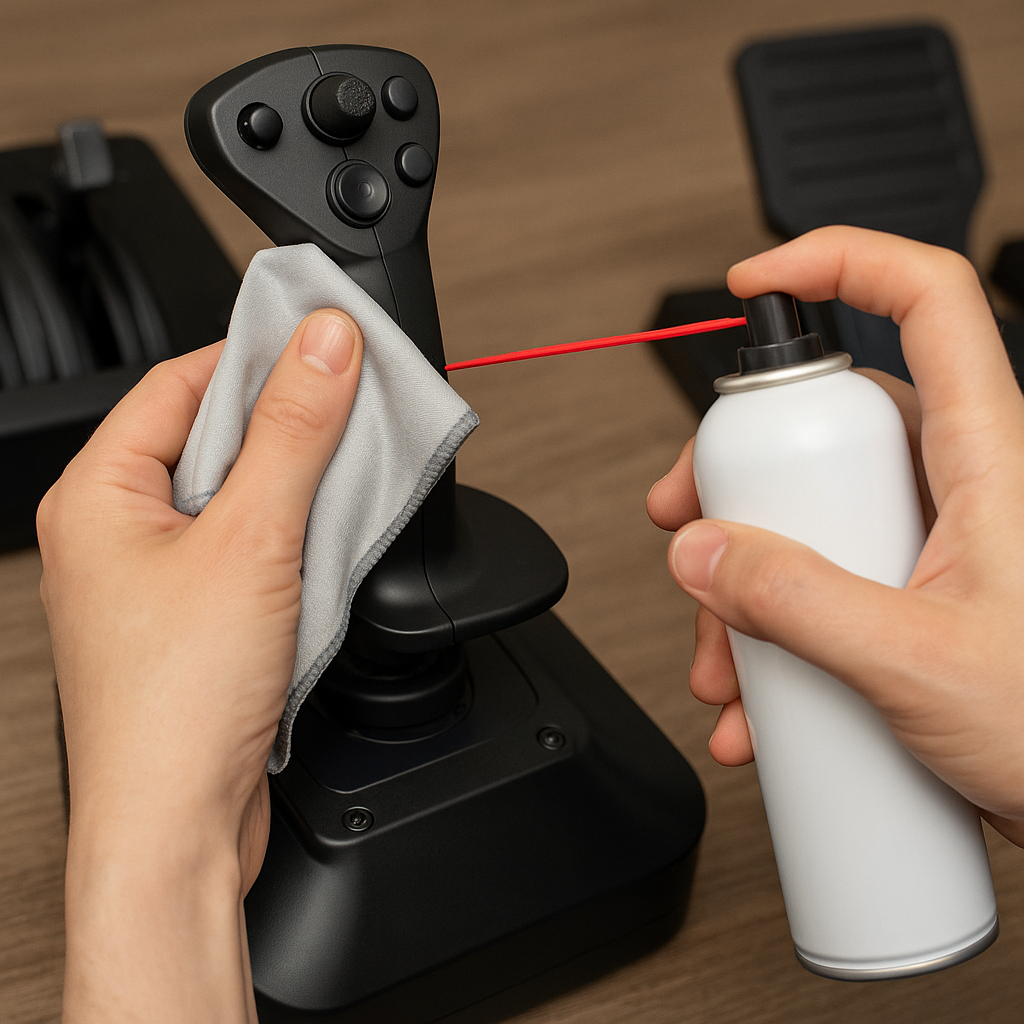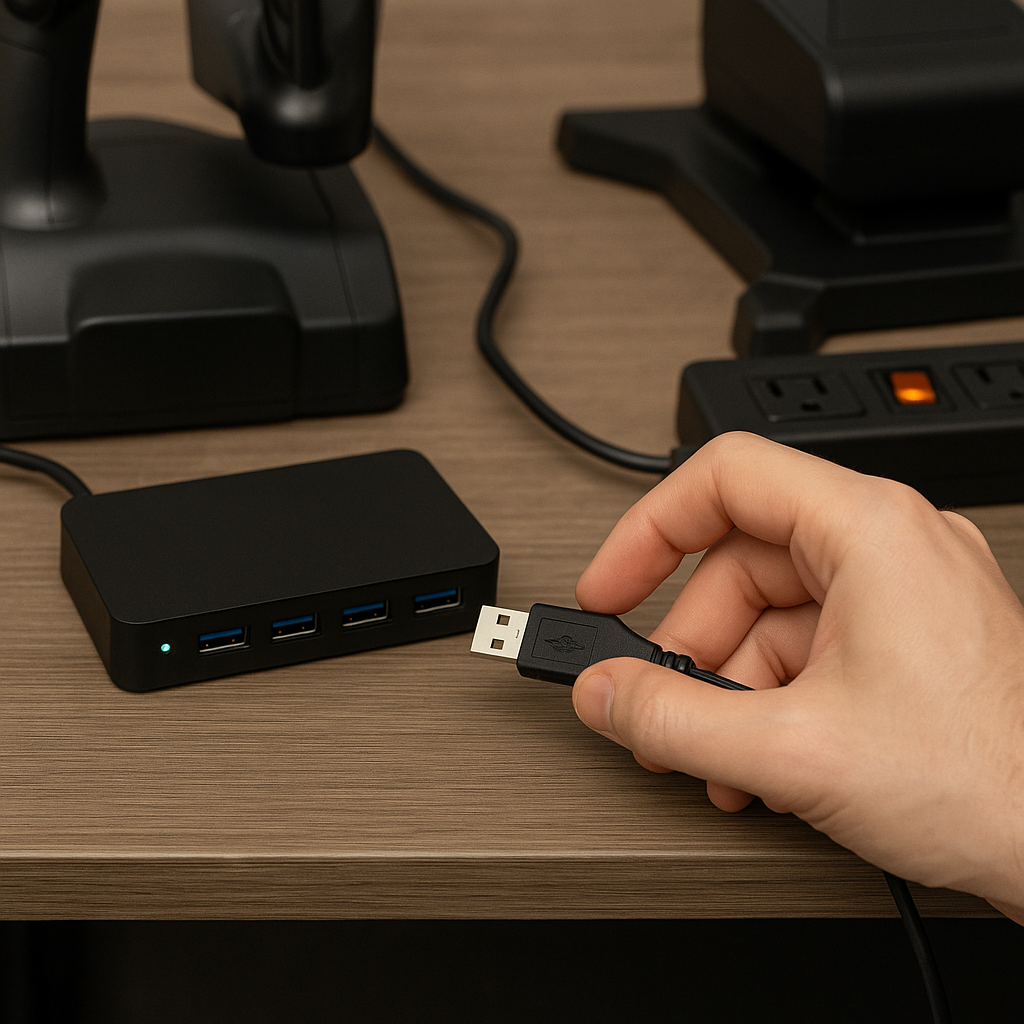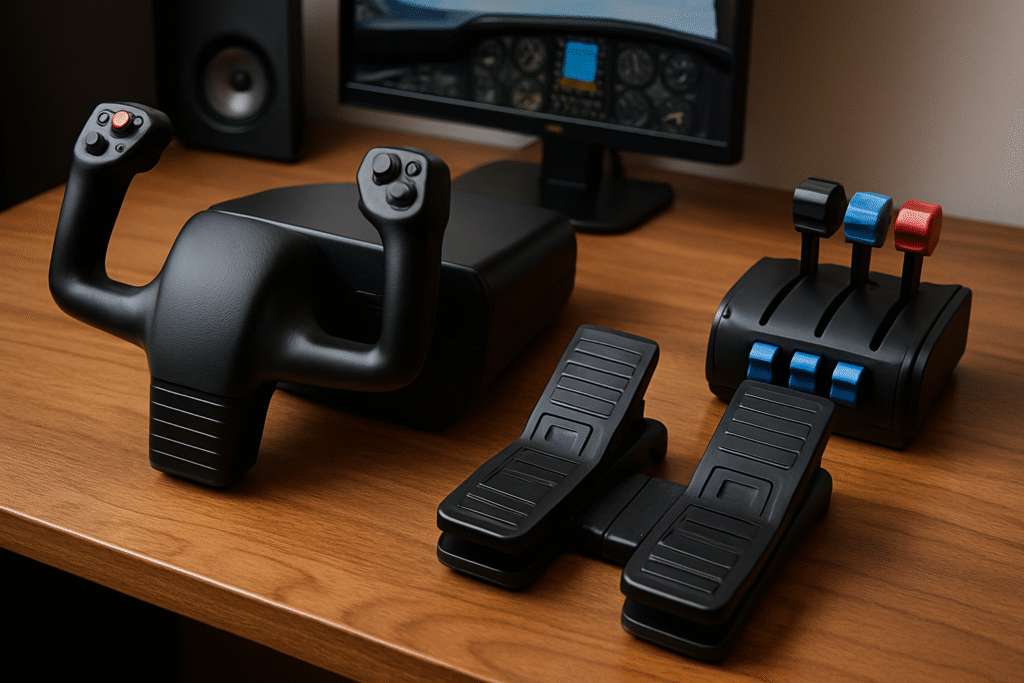Last updated on May 23rd, 2025 at 10:37 pm

Dust might seem harmless, but over time it can affect your gear’s performance — from joystick sensors to throttle quadrants and rudder pedals. A little regular TLC keeps things running like new. If you’re curious about improving your setup, check out our guide on The Best Joysticks for a Realistic Flight Experience.
So, how do you keep everything spick and span? Grab a soft microfiber cloth and a can of compressed air — these are your best friends when it comes to cleaning surfaces and clearing out those tight spots where dust loves to hide. Be sure to hold the can upright and use short bursts to avoid any residue. For more detailed cleaning and maintenance advice, check out this excellent guide on simulator maintenance tips and best practices. Be sure to hold the can upright and use short bursts to avoid any residue.
Harsh chemicals are a no-go. They can wreck plastic or rubber parts, and before you know it, you’ve got cracked surfaces and a heap of regret. Stick to basic, gentle cleaning methods to keep your gear looking and feeling great.
Lastly, develop a routine. Integrate cleaning into your maintenance schedule, maybe after every few flights if you’re a frequent flyer. It doesn’t take long and your gear will thank you for it, performing smoothly and looking sharp every time you sit down to fly.
Connection Assurance: Avoiding Mid-Sim Crashes

You’ve got this incredible setup, but all those cables and connections can become a weak link if not managed well. Regular check-ins on your connections can prevent some serious simulation interruptions.
Take time to check your USB cables and hubs regularly. Are they firmly plugged in? Any signs of fraying or bent connectors? For hardware that takes your realism even further, explore How to Select the Right Rudder Pedals for Your Simulator. Replace anything questionable before it disrupts a flight.
Check for any visible damage. Frayed cables or bent connectors? Time to replace them. No one wants an epic flight cut short because of a dodgy connection. Also, those USB ports? Keep an eye on them to make sure that they’re clean and free from dust or debris.
Power strips and quality surge protectors are a smart addition to your setup. They safeguard your gear from power surges like a boss and add that extra layer of security when plugging and unplugging devices.
Finally, make it a habit to do these checks periodically. Not only does this help maintain your gear’s performance, but it also gives you peace of mind knowing that everything’s plugged in correctly and ready for action.
Moving Forward: Lubrication and Wear Management

When it comes to keeping your simulator gear in top shape, it pays to give some love to those moving parts. For high-end yokes, throttle quadrants, and pedals, lubrication can be a game-changer.
Start by identifying which parts need lubrication. These are typically the areas that have a lot of movement and might show signs of sticking or squeaking. But warning! Not all lubricants are created equal. Stick to silicone-based lubricants. Household oils can attract dust and grime, or worse, damage components altogether.
Keep an eye out for signs of wear and tear. Buttons, switches, springs, and cables can all start to show their age with heavy usage. If you notice any performance dips, it might be time to look at replacement parts. Thankfully, many brands offer replacements, so you’re not stuck playing with subpar equipment.
Maintaining your setup also means ensuring everything stays put during simulations. Secure mounts and desk arrangements prevent anything from shifting mid-flight, keeping immersion intact and your gear safe from unexpected tumbles.
Stay proactive with maintenance and your gear will reward you with smooth, uninterrupted flight sessions that feel as good as day one.
Staying Current: Firmware and Software Updates

In the tech world, staying up to date can make all the difference, and your simulator gear is no exception. Firmware and driver updates are like secret weapons that can boost performance, fix pesky bugs, and sometimes, even unlock some cool new features.
Check your gear’s manufacturer site from time to time — those updates often fix bugs, improve compatibility, and sometimes even add cool new features. Regular updates keep your system aligned with new simulator versions and operating systems, ensuring you get the best possible experience every time you fly.
When you’re updating, follow any instructions or guidelines provided by the manufacturer closely. Some updates might require specific steps during installation. This precision will save you from any potential headaches.
Updates can also help with compatibility. Whether it’s new operating system versions or your favorite simulation software updates, keeping everything aligned means smoother flights and fewer surprises. It’s like giving your setup a mini-upgrade without spending a dime.
Making this a regular part of your maintenance routine can keep your gear running smoothly, ready to give you the best virtual flying experience each and every time.
Environment and Storage: The Ambient Influence

Keeping an eye on your gear’s surroundings can be a game-changer for longevity and performance. Heat is a top nemesis of electronics, so ensuring your PC or console has room to breathe is crucial. Avoid stacking items on top of vents or placing your setup in an enclosed space where heat has nowhere to escape.
Proper ventilation isn’t just about keeping things cool; it avoids unnecessary thermal throttling, where performance dips to keep hardware safe from overheating. It’s all about giving your gear some space to chill—literally!
If you’ve got portable hardware or you’re packing things away temporarily, storage practices matter. Store your equipment in a dry, dust-free area. Using padded storage cases or even the original packaging can help prevent damage while stored, protecting your investments from dings and bumps.
Think of your setup as a part of your home that prospers with a bit of attention to detail. A well-organized, ergonomically sound environment not only protects your gear, but also enriches your overall simulator experience. If you’re ready to elevate your setup, don’t miss Building a DIY Home Cockpit on a Budget.
Keeping Your Gear in Top Shape
I hope you found this post helpful when it comes to keeping your simulator hardware clean and running smoothly. A bit of maintenance can really go a long way in extending the life of your gear and keeping things performing at their best.
If you’ve got your own tips, questions, or experiences, I’d love to hear from you — feel free to drop a comment or explore more articles to keep improving your flight sim setup.

In my opinion, routine maintenance is vital to keep enjoying a good experience. Thank you for providing these valuable tips for keep our equipment clean and in great working performance. The last thing I would want is for a session to be cut short due to overlooking routine maintenance. I believe this to be a good practice with all the devices we own. A clean and properly maintained device will provide longevity preserving equipment that can be costly to replace or repair.
Thank you for your thoughtful comment! I’m glad the tip about maintaining flight simulation equipment resonated with you. You’re absolutely right—routine maintenance really does go a long way in keeping our devices running smoothly and avoiding costly repairs. It’s a small habit that makes a big difference in the long run.
Regular maintenance of your simulator’s hardware is essential to ensure optimal performance and longevity. Based on experience, key steps include routinely cleaning components to prevent dust buildup, checking for loose connections, and updating firmware to avoid software conflicts. Additionally, monitoring system temperatures and ensuring proper ventilation can prevent overheating and hardware degradation. In my opinion, proactive maintenance not only reduces unexpected downtime but also enhances the realism and reliability of simulations, making it a worthwhile investment of time and effort.
I absolutely agree—maintenance is key to keeping your simulator hardware running smoothly and extending its lifespan. Taking the time to clean components, check connections, and ensure proper ventilation really goes a long way. It not only helps prevent performance issues but also preserves the overall feel and realism of the simulation experience. Thanks for sharing your insight!
This is a fantastic and practical guide for any flight sim enthusiast! Maintenance often gets overlooked, but your tips are spot on — especially the reminder to use silicone-based lubricants and avoid harsh chemicals. I appreciated the emphasis on routine upkeep and connection checks, which can prevent frustrating mid-flight issues. The section on ventilation and proper storage is a great touch — too many setups suffer from heat buildup or poor cable management. I also liked how you tied in links to other helpful resources, like joystick and rudder pedal recommendations. It’s clear that caring for your gear ensures a smoother, more immersive experience. Thanks for the thorough advice — I’ll definitely be incorporating some of these tips into my maintenance routine!
Thanks again for visiting the site, Andrejs—really appreciate your thoughtful feedback! You’re absolutely right—regular maintenance is often underestimated, but it plays a huge role in keeping your setup running smoothly and extending the life of your gear. Choosing equipment that’s both durable and easy to maintain can definitely make a difference in the long run. Wishing you all the best as you incorporate these tips into your own routine—here’s to many smooth and trouble-free flights ahead!